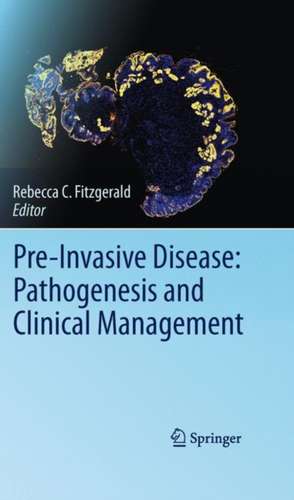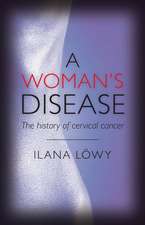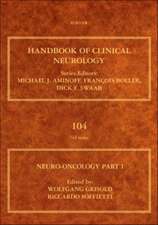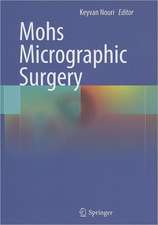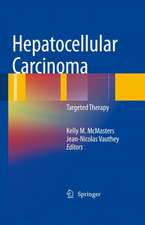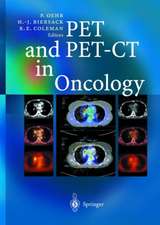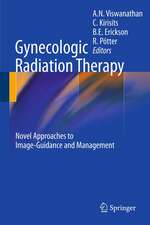Pre-Invasive Disease: Pathogenesis and Clinical Management
Editat de Rebecca C. Fitzgeralden Limba Engleză Hardback – 14 oct 2010
| Toate formatele și edițiile | Preț | Express |
|---|---|---|
| Paperback (1) | 1107.77 lei 6-8 săpt. | |
| Springer – 9 oct 2014 | 1107.77 lei 6-8 săpt. | |
| Hardback (1) | 1113.63 lei 6-8 săpt. | |
| Springer – 14 oct 2010 | 1113.63 lei 6-8 săpt. |
Preț: 1113.63 lei
Preț vechi: 1172.24 lei
-5% Nou
Puncte Express: 1670
Preț estimativ în valută:
213.10€ • 220.18$ • 177.27£
213.10€ • 220.18$ • 177.27£
Carte tipărită la comandă
Livrare economică 19 martie-02 aprilie
Preluare comenzi: 021 569.72.76
Specificații
ISBN-13: 9781441966933
ISBN-10: 1441966935
Pagini: 544
Ilustrații: XXII, 519 p.
Dimensiuni: 155 x 235 x 35 mm
Greutate: 0.9 kg
Ediția:2011
Editura: Springer
Colecția Springer
Locul publicării:New York, NY, United States
ISBN-10: 1441966935
Pagini: 544
Ilustrații: XXII, 519 p.
Dimensiuni: 155 x 235 x 35 mm
Greutate: 0.9 kg
Ediția:2011
Editura: Springer
Colecția Springer
Locul publicării:New York, NY, United States
Public țintă
ResearchDescriere
The majority of cancers present at a relatively advanced stage in which invasion within the primary organ is well established and metastases to lymph and distant organs are either clinically apparent or present at the microscopic level. However, it is increasingly recognized that the natural history of cancer formation is a long and complex path taking many years to develop to a clinically apparent stage in most cases. Furthermore, for most solid tumours there is a pre-invasive or intraepithelial stage of disease. This affords the opportunity for early detection and prevention of invasive disease and hence a cure. However, with this advancing knowledge comes a whole plethora of questions which will be explored in this monograph.
Firstly, we need to understand the global burden of pre-invasive disease and what the public health implications might be for wide-scale screening programmes. In the western world we already have experience of screening for cervical, breast, prostate and more recently colon cancer. As well as their potential benefits these programmes have financial and psychosocial implications which need to be carefully weighed. This is especially true since many pre-invasive lesions will not progress to cancer in a individual’s lifetime. In addition, there are questions concerning whether screening reduces the cancer burden or in fact distorts the survival figures through lead-time bias.
Secondly, at the level of epidemiology and molecular pathogenesis there are important questions regarding the aetiology of pre-invasive lesions; an understanding of which might lead to possible chemopreventive strategies. For example, it would be helpful to know the extent to which the likelihood of developing a pre-invasive lesion is influenced by lifestyle or genetic factors and how these factors influence the risk of progression to invasive disease. At the molecular level we need to understand the pathways and molecular mechanisms, both genetic and epigenetic, by which cells achieve the capacity to invade.
Thirdly, in order make clinical progress we need biomarkers to identify and risk stratify individuals with pre-invasive lesions. These biomarkers might be applied to the serum as in Prostate Specific Antigen in prostate cancer or be applied to tissue samples, such as oestrogen receptor status in breast cancer. In order to utilize biomarkers in the context of a screening programme there are issue around the invasiveness of the test as well as its positive and negative predictive value. With advances in molecular imaging there is now the exciting possibility of incorporating a molecular tag to a non-invasive imaging modality.
Fourthly, in order to justify screening early detection must be coupled to a treatment strategy. If the chemopreventive agent is very well tolerated, then as well as targeting high risk groups, one might consider treatment at the population level. Aspirin is one such drug which has been extensively assessed in the context of colon cancer chemoprevention trials. Trials of aspirin chemoprevention are now being applied to other cancers such as oesophageal adenocarcinoma and since many individuals take aspirin for .chemoprevention of cardiovascular disease the cancer incidence can be ascertained in these populations.
In order to understand the more general issues raised from the discussions above it is useful to consider disease specific examples. Our understanding of pre-invasive disease varies according to the organ site and there are lessons to be learned from these experiences. For example, there is now the prospect of a vaccine for cervical cancer with important questions about how this might be applied to the high incidence areas of the developing world. On the other hand, ductal carcinoma in situ is currently treated by mastectomy which is more radical than the treatment received by many women with invasive disease. Oesophageal adenocarcinoma, which is my own area of expertise is interesting because of the rapid rise in incidence in the western world and the clinically accessible pre-invasive lesion called Barrett’s oesophagus. However, most cases of Barrett’s oesophagus remain undiagnosed and it is not yet clear how to effectively diagnose, monitor and treat this condition without recourse to mass endoscopy with substantial cost implications.
Firstly, we need to understand the global burden of pre-invasive disease and what the public health implications might be for wide-scale screening programmes. In the western world we already have experience of screening for cervical, breast, prostate and more recently colon cancer. As well as their potential benefits these programmes have financial and psychosocial implications which need to be carefully weighed. This is especially true since many pre-invasive lesions will not progress to cancer in a individual’s lifetime. In addition, there are questions concerning whether screening reduces the cancer burden or in fact distorts the survival figures through lead-time bias.
Secondly, at the level of epidemiology and molecular pathogenesis there are important questions regarding the aetiology of pre-invasive lesions; an understanding of which might lead to possible chemopreventive strategies. For example, it would be helpful to know the extent to which the likelihood of developing a pre-invasive lesion is influenced by lifestyle or genetic factors and how these factors influence the risk of progression to invasive disease. At the molecular level we need to understand the pathways and molecular mechanisms, both genetic and epigenetic, by which cells achieve the capacity to invade.
Thirdly, in order make clinical progress we need biomarkers to identify and risk stratify individuals with pre-invasive lesions. These biomarkers might be applied to the serum as in Prostate Specific Antigen in prostate cancer or be applied to tissue samples, such as oestrogen receptor status in breast cancer. In order to utilize biomarkers in the context of a screening programme there are issue around the invasiveness of the test as well as its positive and negative predictive value. With advances in molecular imaging there is now the exciting possibility of incorporating a molecular tag to a non-invasive imaging modality.
Fourthly, in order to justify screening early detection must be coupled to a treatment strategy. If the chemopreventive agent is very well tolerated, then as well as targeting high risk groups, one might consider treatment at the population level. Aspirin is one such drug which has been extensively assessed in the context of colon cancer chemoprevention trials. Trials of aspirin chemoprevention are now being applied to other cancers such as oesophageal adenocarcinoma and since many individuals take aspirin for .chemoprevention of cardiovascular disease the cancer incidence can be ascertained in these populations.
In order to understand the more general issues raised from the discussions above it is useful to consider disease specific examples. Our understanding of pre-invasive disease varies according to the organ site and there are lessons to be learned from these experiences. For example, there is now the prospect of a vaccine for cervical cancer with important questions about how this might be applied to the high incidence areas of the developing world. On the other hand, ductal carcinoma in situ is currently treated by mastectomy which is more radical than the treatment received by many women with invasive disease. Oesophageal adenocarcinoma, which is my own area of expertise is interesting because of the rapid rise in incidence in the western world and the clinically accessible pre-invasive lesion called Barrett’s oesophagus. However, most cases of Barrett’s oesophagus remain undiagnosed and it is not yet clear how to effectively diagnose, monitor and treat this condition without recourse to mass endoscopy with substantial cost implications.
Cuprins
Guest editorial: Professor Sir Bruce Ponder (AGREED)
1. Epidemiology: public health burden, increasing disease and/or increasing detection, lag phase, risk factors ? Prof. John Potter Fred Hutchinson Centre/? Paul Pharoah
2. Pathogenesis:
- cancer stem cells: Prof. Sir Nick Wright, London Research Institute
- inflammation: Lisa Coussens, University California San Francisco
- hereditary factors: Paul Pharoah/Bruce Ponder CRI, Cambridge
- acquired mutations: Doug Hanahan /Robert Weinberg, University California San Francisco
- Epigenetics: E.G. William Nelson Baltimore/ Steve Meltzer John Hopkins USA
3. Animal models and other model systems of pre-invasive disease e.g. Tyler Jacks MIT or Dave Tuveson, CRI cambridge
4. Biomarkers – tissue, serum, fluids: Prof. Brian Reid, Fred Hutchinson Cancer Center, Seattle or Barbara Weber, GSK Pharmaceuticals
5. Molecular imaging: Professor Kevin Brindle Cambridge Research Institute, UK or Gary Kelloff NCI, Rockville
6. Issues around screening/surveillance: psychosocial, economic: Dr. Dawn Provenzale Duke University/ Karen Basen-Engquist MD Anderson texas/ prof Jane Blazeby Bristol UK
7. Disease specific examples:
Lung: Herman Baltimore
Mouth: Miriam Rosin Vancouver
Oesophagus: Dr Rebecca Fitzgerald, Cambridge UK
Stomach: Dr. Tim Wang, Columbia Univ, New York
Colon: Prof Bert Vogelstein, John Hopkins USA, John Potter, Seattle
Breast: Prof Stephen Duffty, CRUK, UK
Cervix –papsmear/vaccines: TC Wu, Johns Hokins Baltimore
Prostate/bladder: Professor David Neal, CRI Cambridge
8. Chemoprevention: e.g. Prof. John Potter Fred Hutchinson Centre
9. Treatment of early lesions: Jacques Van Dam Stanford / or Jacques Bergman Amsterdam
10. Common threads: areas for future research and future costs.benefits to society for early detection: or Michael Sporn Dartmouth Med Sch New Hampshire, or Gary Kelloff NCI, Maryland or Prof. George Triadafilopoulos, Stanford
1. Epidemiology: public health burden, increasing disease and/or increasing detection, lag phase, risk factors ? Prof. John Potter Fred Hutchinson Centre/? Paul Pharoah
2. Pathogenesis:
- cancer stem cells: Prof. Sir Nick Wright, London Research Institute
- inflammation: Lisa Coussens, University California San Francisco
- hereditary factors: Paul Pharoah/Bruce Ponder CRI, Cambridge
- acquired mutations: Doug Hanahan /Robert Weinberg, University California San Francisco
- Epigenetics: E.G. William Nelson Baltimore/ Steve Meltzer John Hopkins USA
3. Animal models and other model systems of pre-invasive disease e.g. Tyler Jacks MIT or Dave Tuveson, CRI cambridge
4. Biomarkers – tissue, serum, fluids: Prof. Brian Reid, Fred Hutchinson Cancer Center, Seattle or Barbara Weber, GSK Pharmaceuticals
5. Molecular imaging: Professor Kevin Brindle Cambridge Research Institute, UK or Gary Kelloff NCI, Rockville
6. Issues around screening/surveillance: psychosocial, economic: Dr. Dawn Provenzale Duke University/ Karen Basen-Engquist MD Anderson texas/ prof Jane Blazeby Bristol UK
7. Disease specific examples:
Lung: Herman Baltimore
Mouth: Miriam Rosin Vancouver
Oesophagus: Dr Rebecca Fitzgerald, Cambridge UK
Stomach: Dr. Tim Wang, Columbia Univ, New York
Colon: Prof Bert Vogelstein, John Hopkins USA, John Potter, Seattle
Breast: Prof Stephen Duffty, CRUK, UK
Cervix –papsmear/vaccines: TC Wu, Johns Hokins Baltimore
Prostate/bladder: Professor David Neal, CRI Cambridge
8. Chemoprevention: e.g. Prof. John Potter Fred Hutchinson Centre
9. Treatment of early lesions: Jacques Van Dam Stanford / or Jacques Bergman Amsterdam
10. Common threads: areas for future research and future costs.benefits to society for early detection: or Michael Sporn Dartmouth Med Sch New Hampshire, or Gary Kelloff NCI, Maryland or Prof. George Triadafilopoulos, Stanford
Notă biografică
Rebecca Fitzgerald is a tenured Programme Leader at the Medical Research Council (MRC) Cancer Cell Unit in Cambridge and her research is in Barrett's oesophagus with a particular focus on early cancer detection. She trained at Cambridge University, conducted her doctoral research at Stanford University, California and came to the UK for her post-doctoral research and specialist clinical training at St. Barts and the London Hospitals before returning to Cambridge. Rebecca maintains an clinical active practice as an honorary consultant in Gastroenterology at the University teaching hospital Addenbrooke's and enjoys teaching in her capacity as Director of Studies at Trinity College, Cambridge.
Textul de pe ultima copertă
There are many books written on cancer, but this monograph focuses on pre-invasive disease. One of the prizes waiting to be won in cancer medicine is to thoroughly understand the processes by which a cell becomes invasive. This quest takes us into the world of stem cells and regulation of gene expression as well as to an understanding of the relative contribution of hereditary factors alongside exposures to environmental agents. This book explores these fundamental concepts as well as considering how advances in disease models combined with –omic technologies and molecular imaging might lead to advances in treatments such as chemoprevention and endoscopic treatments. The final section of the book takes nine specific examples of pre-invasive disease and explores the current state of knowledge and clinical practice as well as looking to the future.This book is written by International experts in their field and should appeal to students and seasoned researchers, to scientists and to clinicians. No prior knowledge of the topic is required to appreciate this text and yet the book charters new territory. New perspectives are given on how our knowledge of cancer development might lead us to reconsider our clinical approach to early detection and prevention of cancer at an individual and population level.
Caracteristici
In an era in which preventive medicine is a major concern for consumers, health-policy makers and politicians pre-invasive disease is likely to become a major part of cancer medicine.
There are a wide range of issues which need to be discussed in order to bring advances in our understanding to the clinic.
It is hoped that this monograph will be a valuable source of information for all those interested in the field.
There are a wide range of issues which need to be discussed in order to bring advances in our understanding to the clinic.
It is hoped that this monograph will be a valuable source of information for all those interested in the field.
